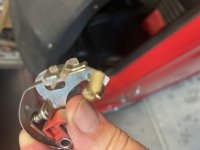KVH
Obi Wan
Offline
I rebuilt my carbs two weeks ago and proudly announced how perfectly my engine was running. That truly was the case, but now I’m back to the same problems with this car, TR4A. Yesterday, after a nice drive, I restarted the engine to head home, and it started right up. But, suddenly, the rpms slowed, the engine chugged and shut right down on me. The car backfired, and smoke puffed from the exhaust pipes. My friend said the puff was grayish brown.
I pulled the plugs and they were a bit black, from a slightly rich mixture. I leaned up the carbs two flats, put in brand new spark plugs, and the car started right up smooth as ever, but only for 25 seconds. It chugged and shut right back down.
My coil was very hot if that’s any clue. Not sure why it would be so hot since the car was hardly running. Current to the coil is good, and the connections are solid. My fuel pump is fairly new, maybe one year old. I had just filled the gas tank the evening before.
I’m at such a loss, having checked so many things. It seems I ought to start random steps: Like a new distributor cap; new rotor; maybe blow compressed air back in the fuel line to the tank to see if there’s a clog; check my generator connections and my battery post connections.
But first, as usual, I’d value the input from this forum. Any thoughts appreciated.
I pulled the plugs and they were a bit black, from a slightly rich mixture. I leaned up the carbs two flats, put in brand new spark plugs, and the car started right up smooth as ever, but only for 25 seconds. It chugged and shut right back down.
My coil was very hot if that’s any clue. Not sure why it would be so hot since the car was hardly running. Current to the coil is good, and the connections are solid. My fuel pump is fairly new, maybe one year old. I had just filled the gas tank the evening before.
I’m at such a loss, having checked so many things. It seems I ought to start random steps: Like a new distributor cap; new rotor; maybe blow compressed air back in the fuel line to the tank to see if there’s a clog; check my generator connections and my battery post connections.
But first, as usual, I’d value the input from this forum. Any thoughts appreciated.

 Hi Guest!
Hi Guest!

 smilie in place of the real @
smilie in place of the real @
 Pretty Please - add it to our Events forum(s) and add to the calendar! >>
Pretty Please - add it to our Events forum(s) and add to the calendar! >> 

